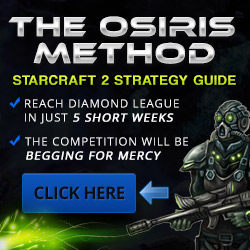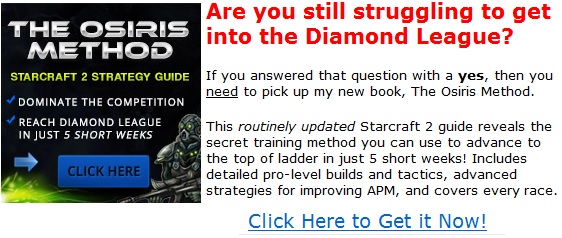Starcraft 2 Counters List
 At a basic level, Starcraft 2 is a giant (and exciting)
game of rock-paper-scissors. Unit A defeats Unit B, Unit B defeats Unit C, and Unit C defeats Unit A. You will
win a lot of games just by building whatever counters your enemy's units! At a basic level, Starcraft 2 is a giant (and exciting)
game of rock-paper-scissors. Unit A defeats Unit B, Unit B defeats Unit C, and Unit C defeats Unit A. You will
win a lot of games just by building whatever counters your enemy's units!
Note that there are two types of counters: "hard counters" and "soft counters". A hard counter
describes the situation where one unit is completely dominant over another. A soft counter
describes the situation where one unit is effective versus another unit, but it is not necessarily a landslide.
Hard counter example: The Immortal is a hard counter for the Roach. Four Immortals can defeat 24 Roaches.
Soft counter example: The Marauder is a soft counter for the Stalker. Marauders will beat Stalkers in 1v1
combat, but 12 Stalkers will defeat 6 Marauders without a problem.
I have broken down this Starcraft 2 Counters List into 2 sections:
Counters by Race
On the left hand navigation menu under the "Starcraft 2 Counters List" tab, you will find three pages:
Each of these pages lists its prospective race's units along with of all its hard counters in
Starcraft 2.
You will want to use these sections in two ways. First off, if you are always losing to a certain race, check
out its counter list. Also, you can also check out the counter list for your preferred race so you can see what to
avoid building.
For example, I have listed the Zergling as a counter to the Marauder. If your enemy has massed Zerglings, you
know you definitely do not want to respond by massing Marauders in return.
Note: I have not included every single unit counter, just the ones you will want to pursue. For example, any
ranged armored unit counters the Reaper, but most players use Reapers to rush, so adding in Immortal would be sort
of pointless. Immortals do counter the Reaper, but Terran players are not using Reapers in any significant number
by the time Immortals appear on the field.
As an example of this impacts the charts, for Protoss I mentioned Stalker and Photon Cannon rather than the
Immortal. Immortals counter Reapers, but you would never build Immortals for the express purpose of warding off
Reapers when you could use Stalkers.
Counters by Unit
However, not every unit has neat counters that can be put into charts. Let's look at the Siege Tank for example.
Technically, this unit is countered by any air unit, since it can only hit ground units. For example, the Mutalisk
could be considered a "hard counter" to the Siege Tank.
In practice, this does not work like that. No player in the Gold league or higher is stupid enough to build
Siege Tanks without backing them up with Thors against Zerg players. In fact, most players do not mass a single
unit but rather get several complimentary units. Thors are a hard counter versus Mutalisks, and as a result, Thors
+ Siege Tanks are still effective against Mutalisks.
Additionally, some counters are situation dependent. For example, the Colossus can be both strong and weak
against Zerglings, depending on the number and supporting units. One Colossus caught in the open field can be
quickly taken down by 12 Zerglings (12 Zerglings have the same supply cost as 1 Colossus).
Despite this weakness, the Colossus is generally considered a counter to the Zergling, because players never get
just one Colossus and they never use Colossi without other units for support. The Colossus rapidly becomes stronger
against the Zergling when it has Sentry support, as Force Fields can prevent. Additionally, since Colossi deal
splash damage from a long range, adding more Colossi allows the Protoss player to take out more Zerglings before
they ever get in range. The end result is that in large enough numbers, the Colossus goes from being weak against
Zerglings to be very strong against them.
As a result, you have to take all counters with a grain of salt. Focus on building balanced armies and strong
unit combinations, only resorting to specific counters when your enemy makes the mistake of massing just one or two
types of units.
Unit Specific Starcraft 2 Counters (more coming over time)
Since counters are not always cut and dry, in this section I will be adding more pages for specific units in the
way that you will actually encounter them in a competitive match. This is particularly enlightening for units that
are not used to attack directly where a simple chart cannot convey the intricacies of a given unit.
For example, the Oracle is a Protoss unit that is particularly effective against light units. It has an
energy-based attack which depletes very rapidly, giving it a short window with which to attack the opponent.
Relative to its high cost, this unit has a relatively low health and armor rating.
As a result, players do not use the Oracle as part of their main force, but instead use just one or two at a
time to kill off enemy workers. Since the Oracle is a low HP unit and cannot attack other air units, it is
technically countered by all air units with an anti-air attack as well as any armored ground unit with an anti-air
attack.
However, players typically rush to the Oracle, trying to attack with one before the Terran enemy has a unit that
is capable of hard-countering the Oracle. Additionally, Protoss try to snipe workers with the Oracle, ignoring
their enemy's army entirely. It is not very helpful to say that a unit like the Viking is a counter for the Oracle,
because a Protoss player will rush to an Oracle and get one out much faster than the Terran player is able to get
out a Viking.
The chart alone cannot communicate how to stop a unit like this based on "counters". These pages below will
cover the specifics of how to stop a particular enemy unit. If you always feel like you lose to one unit in
particular, this is a good place to check.
Counters by Army and Dealing with High Threat Units
Once you get out of the Bronze or Silver league, it is very rare to see players simply mass one particular unit,
particularly in the late game. Instead, they focus on balanced army types that can typically take on any sort of
combination of enemy units.
Assuming micro, army size, and tech are equal, the winner of the battle is the person's who best counters the
opponent's army as a whole. In particular, "countering the opponent's army" refers to your ability to either
quickly take down the enemy's high-threat units or at the very least limit the effectiveness of these units. A
high threat unit is any unit that is able to deal very high DPS or cast powerful abilities and will wreck
your army if you do not do something about it.
For example, imagine a Protoss vs Terran match-up. The Protoss' Colossus and High Templar units are very strong
against the Terran's bio-based army. Psionic Storm from the High Templar in conjunction with splash damage from the
Colossus' attack will quickly melt Terran bio forces.
The Terran's Ghost can counter the High Templar, but only if you specifically use the Ghosts to Snipe or at
least EMP the High Templar before they can use Psionic Storm. The Terran's Vikings can quickly burst down Colossi,
but only if you have enough Vikings and only if you focus fire down the Colossi while simultaneously avoiding
losing your Vikings to Stalkers.
Summary
As you can see through the Terran vs Protoss example in the previous section, counters are important, but they
are only a small part of playing Starcraft 2. You should know all of the unit counters for the race you are
playing, but you will have to master all aspects of Starcraft 2 before you can significantly increase your ladder
ranking.
Now that Starcraft 2 has been out awhile, the influence of counters on winning games is smaller than ever: the
majority of players already know all the counters, so mastering these counters will only put you on equal footing
with your competition. If you do not know the counters at all, you will be at a big disadvantage.

| 
